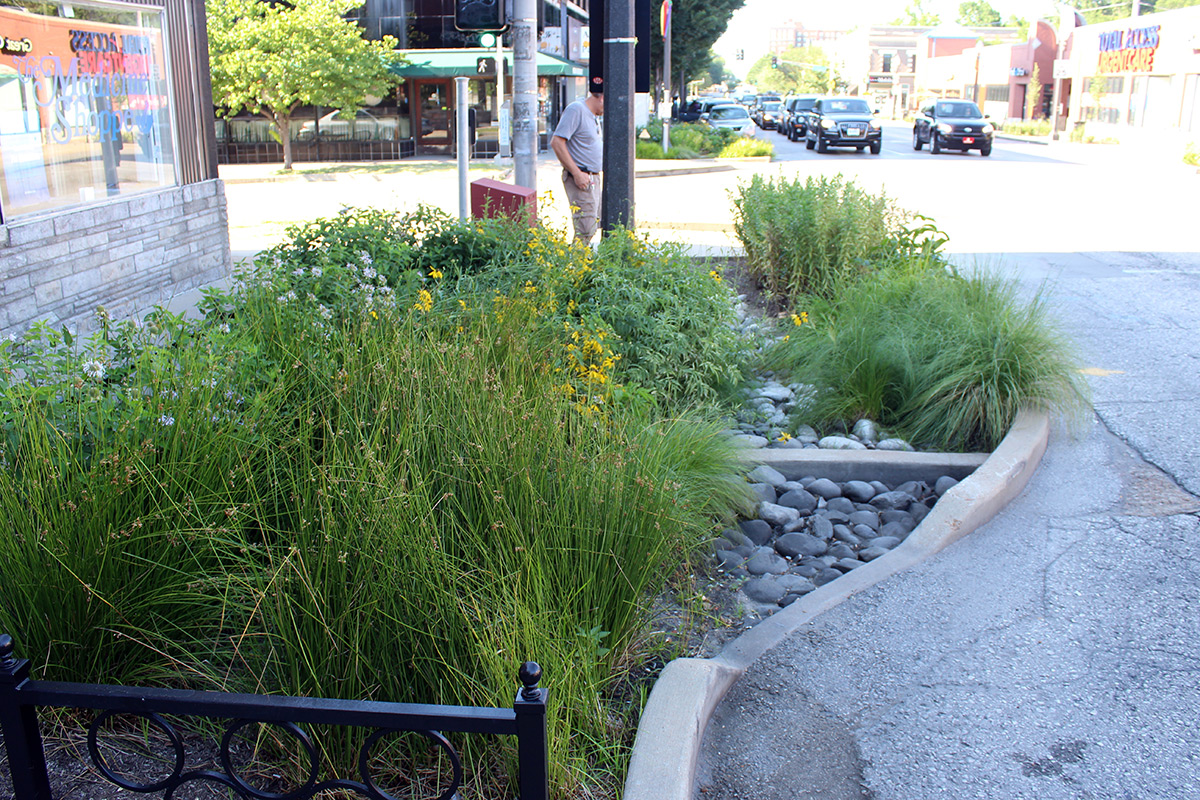Our Work Stormwater & Green Infrastructure Programs & Initiatives Green Stormwater Infrastructure: Illinois Groundwork
Green Stormwater Infrastructure: Illinois Groundwork
When it rains, most of us don’t think about where the water goes—until the water has nowhere to go. When rainfall overwhelms our stormwater drainage infrastructure capacity, flooding occurs. One way to address flooding is through capturing and infiltrating stormwater onsite using green stormwater infrastructure.

GSI Example: Bioinfiltration cell along an urban street
Green stormwater infrastructure (GSI) uses design strategies—such as rain gardens and permeable pavement systems—that slow, cool, and cleanse stormwater to alleviate urban and downstream flooding and to improve water quality. To help Illinois communities implement GSI design, we have created an Illinois Groundwork program with a website that provides information on GSI, an in-depth design process guide, and additional resources such as a plant finder, sizing tool, built examples, and regulations to consider.
During large rainstorms, many Illinois residents brace themselves for their basements, streets, and neighborhoods to flood. In recent decades, large rain events are more frequent, creating even more flooding. In fact, every single county in Illinois has experienced flooding severe enough to be a Declared Presidential Disaster.
In the past, engineers solved flooding by installing gray infrastructure—typically storm sewers that drain runoff to lakes and streams. This has not been without consequence, however, as it causes another problem—impaired water quality in tens of thousands of acres of Illinois lakes and hundreds of miles of its streams.
Impervious surfaces, like concrete and asphalt, create even more runoff volume. The combination of more runoff and stronger storms causes rainwater to overwhelm the storm sewer system. The resulting flooding often causes billions of dollars in damage.
The green stormwater infrastructure approach augments traditional gray infrastructure systems by capturing and infiltrating a portion of stormwater runoff onsite, thereby alleviating flooding and improving water quality, while also providing health, environmental, and economic benefits to communities.
The Illinois Groundwork design process was developed through a project that included two pilot communities in Chicago’s Calumet region that had the goal of integrating soils performance into GSI design.
About the GSI Design Process
The foundation of GSI performance is soils. Soils characteristics establish infiltration rate—how fast water enters and is absorbed by the soil. Water infiltration is important, as water that is not infiltrated into the ground causes runoff and flooding. The more infiltration, the less flooding.
The Illinois Groundwork guide is designed to support you in integrating soils research into GSI planning. It answers questions such as:
- What steps are necessary to understand soils and conduct soils fieldwork?
- Once you have soils data, how can you integrate it into GSI design?
- How can you bring collaborative engagement to the project?
- What actions can you take to advance the project—are you ready to implement, or is more work needed to address project barriers and specific community needs?
Learn More
Ready to investigate GSI design for your community? Here are the steps you’ll learn about to integrate soils research into green stormwater infrastructure planning:
- Use an engagement process to build bridges between community members, stormwater professionals, and university researchers.
- Investigate native subsoils by collecting existing soils data to inform site location and conducting fieldwork to collect soils samples for a site soils analysis.
- Connect soils characteristics with GSI design; to size, scale, and estimate runoff reduction.
- Implement GSI, including final design specifications (such as choosing plants), costs and funding, and installation and maintenance.
To get started, visit illinoisgroundwork.org

